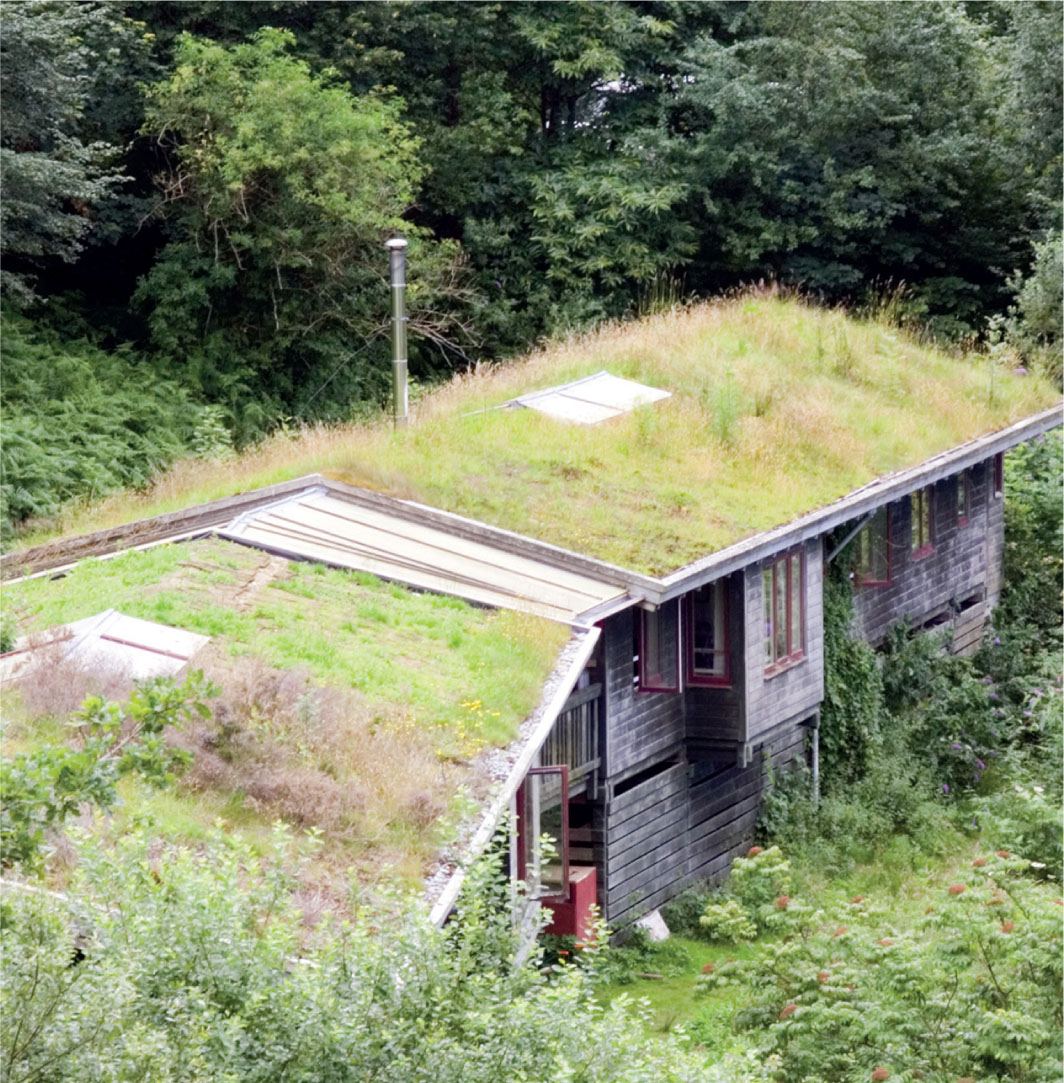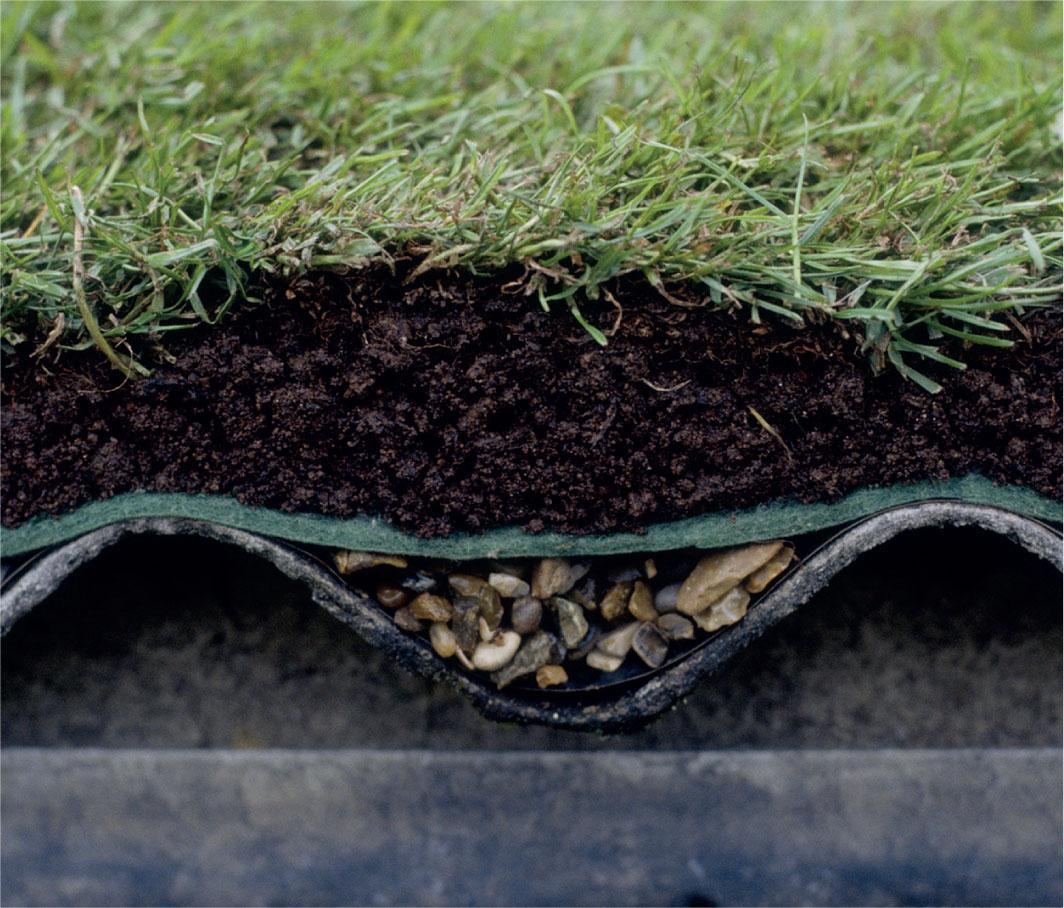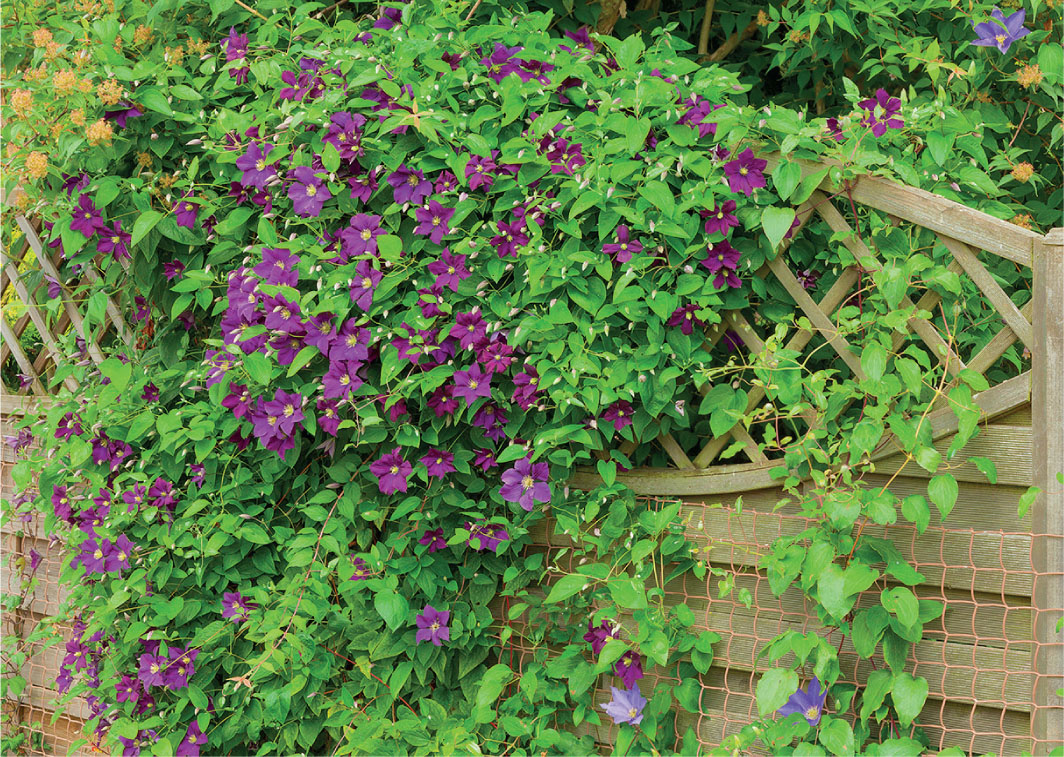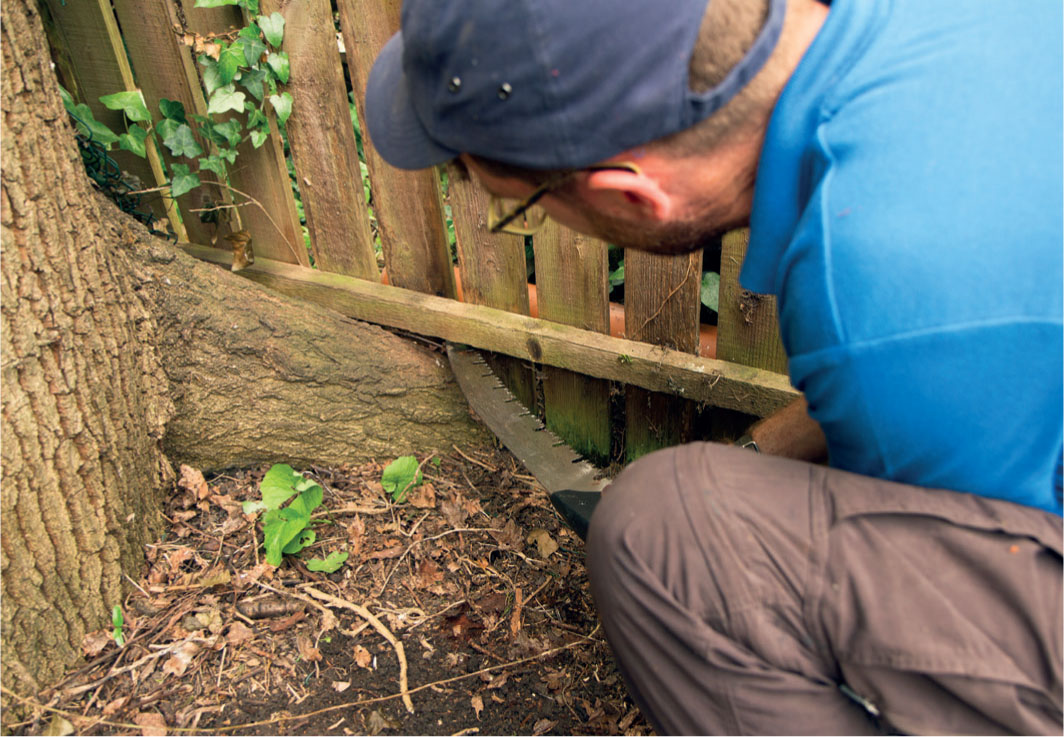 Only your tyres really need to sit on something hard, so why not limit yourself to a two-track driveway with grass either side and down the middle.
Only your tyres really need to sit on something hard, so why not limit yourself to a two-track driveway with grass either side and down the middle.Gardening for Wildlife in the Function Zone
You’ll remember that wildlife-friendly gardening is at its best when you incorporate it everywhere, no matter what other needs you have from your garden; all it takes is imagination.
Perhaps the last place you might think of doing things for wildlife is what I call the ‘Function Zone’, those dull bits such as paths, drives and sheds that allow us to move about the garden or store things. And yet, with a bit of creativity, they can be turned into useful features for wildlife too.
Driveways
Most people need somewhere to park their car (or three), and it is so easy to believe that you’ve got no choice but to sacrifice a big chunk of your garden (and its wildlife potential) under tarmac or paving.
Here are your wildlife-friendlier alternatives:
 Only your tyres really need to sit on something hard, so why not limit yourself to a two-track driveway with grass either side and down the middle.
Only your tyres really need to sit on something hard, so why not limit yourself to a two-track driveway with grass either side and down the middle.
 Or use one of the modern ‘cellular paving’ or ‘ground reinforcement’ systems, which are honeycombs strong enough to park on but where the gaps can be seeded with grass. Typical systems include grids of interlocking recycled plastic (below), while ‘grasscrete’ is a bed of concrete studded with holes.
Or use one of the modern ‘cellular paving’ or ‘ground reinforcement’ systems, which are honeycombs strong enough to park on but where the gaps can be seeded with grass. Typical systems include grids of interlocking recycled plastic (below), while ‘grasscrete’ is a bed of concrete studded with holes.
 Neither system will give you a perfect lawn but it will be green, hardwearing, kind on the worms and will dramatically reduce the area of your world lost to tarmac. And because the water can soak into the soil, it will also help reduce the risk of flash flooding. Isn’t it about time that all new drives were like that?
Neither system will give you a perfect lawn but it will be green, hardwearing, kind on the worms and will dramatically reduce the area of your world lost to tarmac. And because the water can soak into the soil, it will also help reduce the risk of flash flooding. Isn’t it about time that all new drives were like that?


Paths
So you’ve parked your car on your new cellular ground-reinforced drive, but you still need a good firm surface to get you to your front door and around the garden. The usual solution in most gardens is a continuous paved or concrete path, losing many more square metres of garden to hard landscaping.
Time for some more wildlife-friendly options:
 There are lightweight versions of cellular paving on the market to try, or create ‘mesh-protected turf’ (don’t you just love all this jargon?). The mesh is made from tough plastic and is simply laid over existing grass, pegged down, and the grass grows through. It can then be mowed and cared for much like a normal lawn.
There are lightweight versions of cellular paving on the market to try, or create ‘mesh-protected turf’ (don’t you just love all this jargon?). The mesh is made from tough plastic and is simply laid over existing grass, pegged down, and the grass grows through. It can then be mowed and cared for much like a normal lawn.
 In woodland areas, try a bark path instead of concrete or paving.
In woodland areas, try a bark path instead of concrete or paving.
 If you must have concrete slabs, then don’t butt them right next to each other but lay them as stepping-stones with grassy gaps in between (above) – that’s more green space saved.
If you must have concrete slabs, then don’t butt them right next to each other but lay them as stepping-stones with grassy gaps in between (above) – that’s more green space saved.
 Of course, where possible have grass paths – they are by far the best for wildlife.
Of course, where possible have grass paths – they are by far the best for wildlife.
Green and brown roofs
We tend to think of roofs as the things that keep our possessions and us safe and dry, end of story. Bar the odd bird singing from the gable end and a splattering of lichens, they don’t seem to have much wildlife value or potential.
If we lived in somewhere like Denmark or Germany, we’d think very differently. There, an estimated 12 per cent of all flat roofs are ‘green roofs’ where insects and other wildlife can thrive. (In the definition of ‘green roofs’ I am including ‘brown roofs’ which have a substrate of rubble and pebbles and shells). Slowly, the number of buildings in the UK with green roofs is increasing, and the list of beetles and spiders that have been found on them is very impressive, showing what can be achieved.

Green roofs also intercept rainwater and help to insulate the house beneath. When you think how much of our landscape is taken up with our houses, you can’t help thinking what a good idea this is.
There’s no denying that retrofitting a green roof is not cheap or easy. Plants need something to get their roots into and that adds up to a lot of weight; some roofs just can’t take it. But the technology is getting ever better, and green roofs are now available weighing about 55kg/square metre, which is within the load-bearing limit of most roofs. And green roofs don’t need to be flat either – their slope can be as much as 45 degrees. At the very least, we all ought to consider a green roof for something like a new shed or flat garage roof.

Although it is possible to use grasses or wildflowers, the usual plant mix is of native and non-native stonecrops (sedums), which are evergreen, flower in summer and are great for bees (left and above). They are grown commercially as a 20mm-thick mat and laid over about 50–70mm of growing medium on top of a waterproof membrane. Stonecrops are the tough-nuts of the plant world, able to cope with just a little soil and all the exposure that our roofs have to endure. Green roofs then just require an annual check to ensure that no tree seedlings have taken root!
If you like the idea, follow the three golden rules:
 Ensure that the building beneath the roof can take the load
Ensure that the building beneath the roof can take the load
 Ensure that the waterproofing layer is waterproof
Ensure that the waterproofing layer is waterproof
 And always take professional advice before you start.
And always take professional advice before you start.

Wildlife-friendly boundaries
Like so many creatures, we love to mark out our territories. We may not have scent glands that we rub against trees and we don’t sing from prominent positions, but we make a pretty strong statement with all manner of vertical structures that clearly say, ‘This is mine; keep out’.
However our boundaries can be a tragedy for wildlife, forming impenetrable, lifeless barriers. Think how challenging it would be for any species trying to navigate the housing estate in the photo below. What a nightmare!
Yet with a little imagination, boundaries can be homes, not assault courses. A hedge is by far the best option (see here), but if you are stuck with walls or fences, there are two key issues that will help wildlife: growing things up them; and making sure wildlife can get over, under or through them.

Making the most of garden walls
Whether made from brick or stone, the solidity of garden walls offers a great surface for training climbing plants. In fact the volume of vegetation you can get to cover them may almost match that of a hedge, offering plenty of nesting sites for birds and leaf fodder for some moth caterpillars. Don’t forget to try espalier fruit trees as well as more obvious climbers.
Walls also create interesting microclimates. On the south side, it may be so warm and sheltered that you can grow unusual plants that would otherwise not survive.
A drystone wall is probably the best for wildlife (above right). They look fantastic, and the materials are often local. The different-sized gaps between the stones are magnificent for all sorts of wildlife from Common Lizards to invertebrates and even nesting Blue Tits, Wrens, Robins and Pied Wagtails, while lichens, mosses and ferns are all likely to colonise.

Covering fences
Ah, fences: not one of our finest inventions as far as wildlife is concerned. But if it is what you’re stuck with, you might as well make the most of them.
 Try to ensure they are made from FSC timber (see here – it will cost more, but save wildlife elsewhere).
Try to ensure they are made from FSC timber (see here – it will cost more, but save wildlife elsewhere).
 Train climbing plants all over them. Use batons to affix trellises a good 4–6cm from the fence to create enticing gaps where insects and Wrens can play hide and seek. Bring trellis supports down to ground level to add more stability to the fence.
Train climbing plants all over them. Use batons to affix trellises a good 4–6cm from the fence to create enticing gaps where insects and Wrens can play hide and seek. Bring trellis supports down to ground level to add more stability to the fence.
 Put Robin and Wren nest boxes on the fence, hidden behind climbers.
Put Robin and Wren nest boxes on the fence, hidden behind climbers.


Hedgehog highways
The problem with most walls and fences is that they block the path of any animal that needs to wander between gardens but can’t climb very high or fly. It’s a difficult problem to solve with an established wall, although growing climbers up them will at least offer ‘wildlife ladders’. If you’re building a wall from scratch, build in tunnels at ground level.
With fences, it is somewhat easier to create gaps along their bases to allow the free-flow of wildlife. Consider also having ‘hit and miss’ fencing, where adjacent slats are offset from each other, or picket fencing, both of which allow the wind and small creatures through. If not, take a saw to the base of a panel (it can be in a corner tucked out of the way) and cut a hole about 12cm square (above), fine for Hedgehogs but too small for most dogs or Foxes. Ideally put one in every 5m or so – but do check with your neighbours before that first cut!

House walls
The big vertical walls of our houses are like sheer cliffs, blank canvases crying out for a wildlife-friendly feature or two. Wonderful climbing shrubs such as wisterias (below left), climbing roses or honeysuckles can be trained up a stout trellis and don’t interfere with the brickwork in the way that Ivy does.
Don’t forget to put up House Martin and Swift nest boxes under the eaves, and house walls are also ideal for boxes for House Sparrows, Starlings, Spotted Flycatchers (place the box among climbers) and Robins (hide the box behind climbers).

Water butts
Watering your garden using rain collected in a butt is clearly environmentally friendly, but the butt itself can be a plastic eyesore and a no-go zone for wildlife.
So here is a challenge to you to come up with ideas for making them work harder for wildlife. Maybe it could be a frame that fits over them that allows climbers such as Hop to cloak them during the summer, which can then be cut away when the butt needs cleaning in winter? Maybe erecting trellis around the butts could do the same job?. Over to you to unleash your creativity…